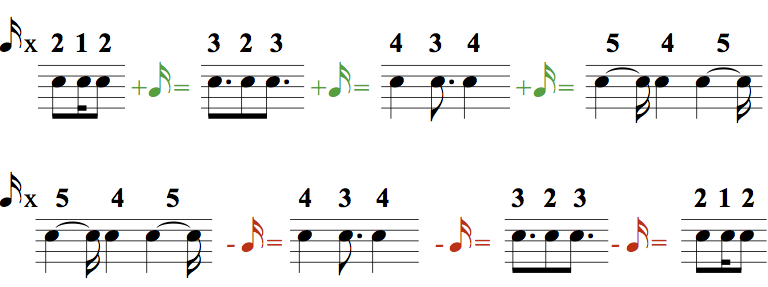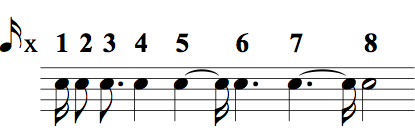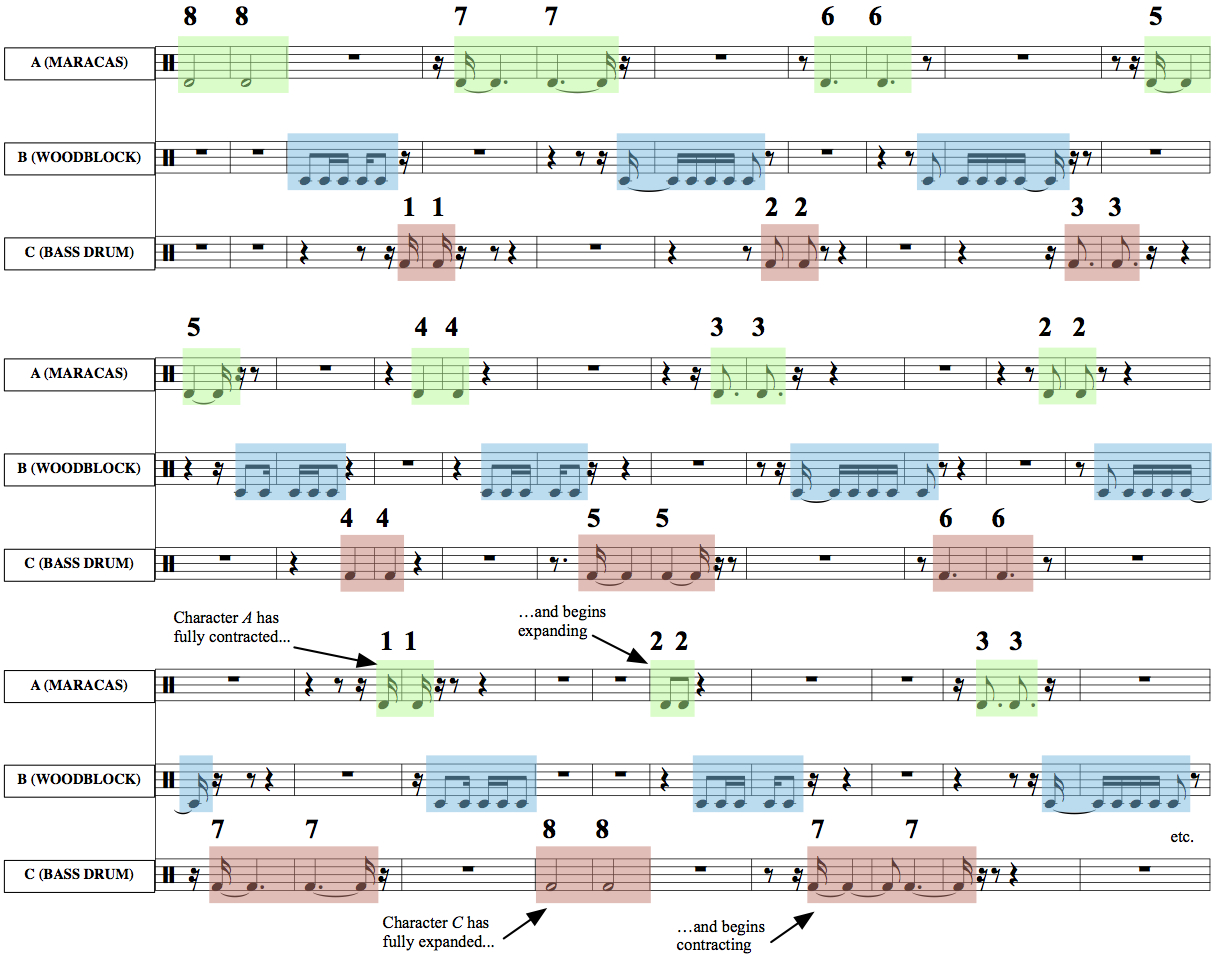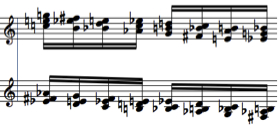This section is by no means complete and will be gradually expanded upon.
- I. Modes of Limited Transposition
- II. Non-Retrogradable Rhythms
- III. Rhythmic Augmentation & Diminution
- IV. Scales of Chromatic Durations
- V. Rhythmic Characters
- VI. Systematic Transposition
MODES OF LIMITED TRANSPOSITION
Often times in Messiaen's music we hear strange chords which sound like major chords with "extra notes". Or sometimes we hear melodies that aren't in major or minor keys, but they also can't be justifiably called atonal. This is because Messiaen derived his own set of modes (these are not the standard modes which are often taught in music theory -- i.e. dorian, lydian, etc).
Rather, Messiaen's modes are sets of pitches which can be transposed only a certain number of times before ending up with the original set. For instance, we could call the chromatic scale the zeroth mode (although I haven't come across any reference to this elsewhere). Transposing this set up one-half step gives us the exact same set of notes. Similarly, the whole-tone scale is the first mode. If we start with the set P0 {C D E F# G# A#} and transpose it up one-half step, we get the new set P1 {C# D# F G A B}. If we try and transpose the new set P1, we end up with {D E F# G# A# C} -- which is precisely the same as P0 starting on a D instead of a C! See the Wikipedia article Modes of Limited Transposition for a good overview on this topic. I also made a separate post which goes over many of the modes.
Like his predecessor Claude Debussy, Messiaen used parallel motion as a way of harmonization. However, Messiaen applied parallel motion to his set of modes instead of just diatonic, whole-tone, and pentatonic scales. We will use a descending, harmonized scale that appears frequently in part 2 of the 1st movement as an example on how this works.
 |
| Figure 2: Mode 3.1 |
Notice that the top eight notes on the descent are the same as the top voice in the previous figure. Messiaen constructs chords by adding voices -- layers of the same scale, but starting in different places.
 | ||
| Figure 3: A bit messy to read, but it illustrates the idea of adding voices. |
 |
| Figure 4: The final result with a total of 6 voices. |
It is interesting to see how many major chords are embedded within the harmonies. On the top staff, we can see that the first chord is a C major chord, the second chord is a B major chord, the fourth chord is an A-flat major chord, the fifth chord is a G major chord, the seventh chord is an E major chord, and the eighth chord is an E-flat major chord! The bottom staff doesn't contain any major chords, but we can recognize that the third and sixth chords are diminished.
NON-RETROGRADABLE RHYTHMS
Messiaen's music is filled with non-retrogradable rhythms. To "retrograde" essentially means to go back in time, or to reverse. Applied to music, this would mean reading something from right-to-left instead of the usual left-to-right. Thus, a rhythm that is non-retrogradable is one that does not change when it is read backwards. This is the musical equivalent of a palindrome (i.e. "wow" or "Rise to vote, sir").
 |
| Figure 5: Six examples of non-retrogradable rhythms. See below for audio clips of each. |
Example 2:
Example 3:
Example 4:
Example 5:
Example 6:
RHYTHMIC AUGMENTATION & DIMINUTION
One of Messiaen's most frequently used techniques is the augmentation and diminution of a rhythm. This involves repeating some base rhythm and on each repetition adding or subtracting a value. |
| Figure 6: An example of rhythmic augmentation (top) and diminution (bottom) using the base rhythm 2-1-2. Click on image to enlarge. |
For the example of rhythmic diminution (bottom line), notice how the last iteration (2-1-2) cannot possibly be subtracted from without removing the middle note (we would have 1-0-1). There seem to be many cases in Messiaen's compositions where this "triggers" some other event. For instance, in the 3rd movement when the maracas can no longer be contracted any further (see Figure 8 in the "Rhythmic Characters" section), the ondes-Martinot enters with wailing glissandi.
SCALES OF CHROMATIC DURATION
For the trivial case of rhythmic augmentation and diminution, the base rhythm is a single note (i.e. a sixteenth note to which a sixteenth note is added upon each iteration). Then we have what Messiaen refers to as a scale of chromatic durations.
 |
| Figure 7: An example of a scale of chromatic durations in sixteenth notes, ascending from a value of 1 to 8. |
A dramatic example of scales of chromatic durations happens three times in the eighth movement. One group (mostly brass, lower winds, and percussion) plays an ascending scale, a second group (higher winds and strings) plays a descending scale, and a third group plays constant eighth notes -- all simultaneously! It is the sonic equivalent of being drawn and quartered.
RHYTHMIC CHARACTERS
In his scores, Messiaen calls this "rhythmic personnages" which approximately translates to "rhythmic characters". The idea here is that he has a set of three base rhythms -- let's label them A, B, and C (which he often labels them as in his scores). These rhythms are repeated several times in that order -- A, B, C. On each repetition, he alters one by augmenting it by a given value. Likewise, he alters another by diminishing it by the same value. The third rhythm remains constant.
There are several places where this happens during the Turangalila-Symphonie (not to mention the rest of his output), but there is a particularly clear example in the middle of the 3rd movement. Rhythm A is played by the maracas and is diminished by one 16th note, rhythm B is played by the woodblock and remains constant, and rhythm C is played by the bass drum and is augmented by one 16th note.
 |
| Figure 8: An example of "Rhythmic Characters" occurs at rehearsal no. 6 in the 3rd movement. Notice that rhythm B is an example of a non-retrogradable rhythm. Click on image to enlarge. |
SYSTEMATIC TRANSPOSITION
Messiaen also has a melodic counterpart to the technique of rhythmic augmentation/diminution which he calls "Agrandissement Asymetrique". The English translation "Asymmetric Aggrandizement" isn't a good descriptor of the technique (nor does it really make sense), so I am going to call it "Systematic Transposition". For the technique of rhythmic augmentation/diminution, recall how a rhythm is repeated and various notes have values either added or subtracted upon each iteration. Systematic transposition does the same thing, but with transposition of pitches up or down an interval. For instance, let's say that our "melody" is three A's. Now, let's say that the first 'A' will be transposed up 1/2-step on each iteration, the second 'A' will be transposed down 1/2-step on each iteration, and the third 'A' will remain constant.As a more complicated example, let's try and apply the same technique to the first two bars of Mary Had a Little Lamb and see how it evolves.



No comments:
Post a Comment